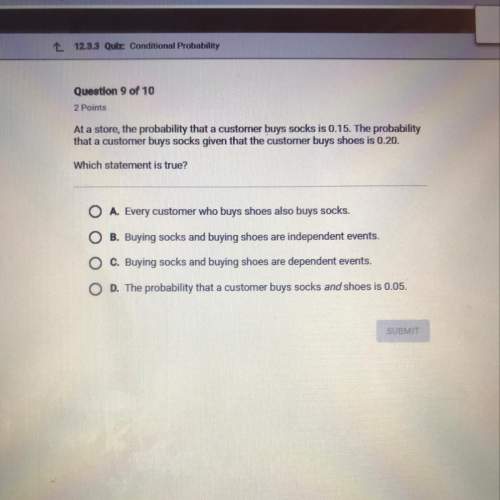Consider rectangle ABCD with diagonals BD and AC intersecting at E.
Rectangle A B C D ha...

Mathematics, 05.05.2020 22:39 gonzalezant8428
Consider rectangle ABCD with diagonals BD and AC intersecting at E.
Rectangle A B C D has diagonals B D and A C that intersect at the center of the rectangle at point E. Angles B C E is 52 degrees, angle C B E is 52 degrees, angle D E A is 104 degrees, and angle B E A is 76 degrees.
Which is true about the angle relationships in the rectangle? Check all that apply.
AngleBEA and AngleCED are vertical angles and equal 76°.
AngleABE and AngleCBE are complementary angles.
AngleBEC and AngleCED are vertical angles.
AngleBEA and AngleAED are supplementary angles whose sum is 180°.
AngleBEC and AngleAED are adjacent angles.

Answers: 2
Another question on Mathematics


Mathematics, 21.06.2019 18:40
The ratios 3: 9, 4: 12, 5: 15, and 6: 18 are a pattern of equivalent ratios in the ratio table. which is another ratio in this pattern?
Answers: 1

Mathematics, 21.06.2019 20:00
Solve for x and y a x= 13.3 y= 16.7 b x= 23.3 y= 12.5 c x= 7.5 y= 16.7 d x=7.5 y= 12.5
Answers: 1

Mathematics, 22.06.2019 00:00
Percy rides his bike 11.2 miles in 1.4 hours at a constant rate. write an equation to represent the proportional relationship between the number of hours percy rides, x,and the distance in miles, y, that he travels.
Answers: 1
You know the right answer?
Questions

Biology, 23.10.2021 01:40

Social Studies, 23.10.2021 01:40



History, 23.10.2021 01:40





Biology, 23.10.2021 01:40

Chemistry, 23.10.2021 01:50


History, 23.10.2021 01:50



Mathematics, 23.10.2021 01:50

Mathematics, 23.10.2021 01:50

SAT, 23.10.2021 01:50

Mathematics, 23.10.2021 01:50

English, 23.10.2021 01:50




